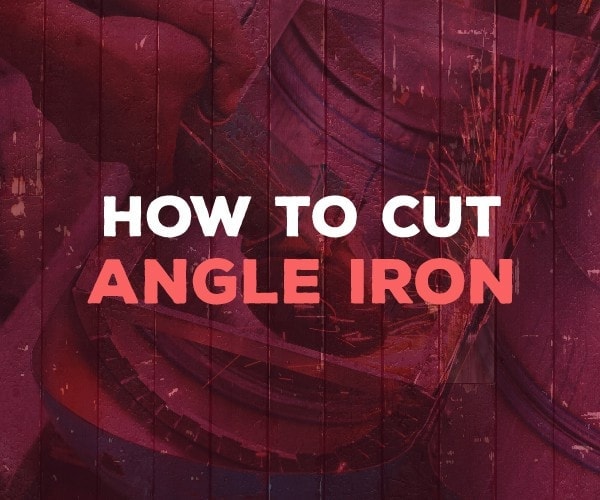Angle Iron is one of the strongest, most versatile and affordable building materials out there. It can be used to create everything from structural supports to shelving to custom furniture to frames for anything from a bed to a go-kart.
Working with angle iron can seem intimidating at first, but our helpful guide here will walk you through everything you need to know about how to cut angle iron quickly and safely.
What You’ll Need
When it comes to how to cut angle iron, all roads lead to Rome. There are many different ways you can cut angle iron, and depending on your project and the tools you have available, some methods may be better suited for you than others.
- Regardless of the tool you use for the actual cutting, you’ll need the following:
- Heavy-duty gloves
- Protective eyewear
- Facemask
- Paint marker (or a sharpie if you don’t have a paint marker)
- Workbench
- Vice (may not be necessary depending on the tool you’re using)
As for the cutting itself, there’s plenty of different ways you can cut angle iron. I’d recommend going with what you have on hand already unless you’re in the mood to purchase some shiny new tools (and face it, who isn’t?)
These different tools make quick work of angle iron:
- Chop saw
- Angle grinder
- Reciprocating saw
- Hacksaw
Step I: Measuring
Regardless of the tool, you’ll use for the job, the first order of business will be to measure for your cut. Once you have your measurement, mark your metal using a paint marker. If you don’t have one, Wite-Out or a Sharpie will work just fine.
Step II: Preparing Your Work Area
Whenever you’re dealing with metal, you’re also going to be dealing with sparks. Sparks start fires. It’s important to take special care when preparing your workstation to ensure that you don’t end up burning the house down because sparks from the angle iron ignited a pile of sawdust from your last project.
Make sure the floor, as well as your workbench, are free and clear of sawdust and other debris before starting. If possible, move the whole job outside and make your cuts in the yard or on the driveway.
Safety extends beyond your work area to what you’re wearing as well. Always wear eye protection and a face mask, and cover exposed parts of your body like your arms and legs whenever possible.
Step III: Cutting Your Angle Iron
Now for the fun part: cutting your angle iron. While the premise is the same regardless of the tool you’re using, they all have some slight variations. Feel free to jump straight to the section that deals with the tool you’re going to use.
Using a Chop Saw
One of the easiest and most effective ways to cut angle iron is with a chop saw.
Outfit your chop saw with the metal cutting blade of your choice. Place the angle iron in the jig with the angled portion of the metal facing upwards and make sure it’s secure.
Next, turn your saw on, and slowly cut through the angle iron.
Using an Angle Grinder
Angle grinders make quick work of most cutting jobs, and if you have one available, they’re perfect for cutting angle iron.
First, secure your piece of angle iron in your vice. Clamp the metal as close to where you’ll be cutting as possible, but make sure that the vice isn’t going to impede your motion at all as you cut.
Next, slowly cut through the metal as shown in the video above.
Using a Reciprocating Saw
If you regularly tackle projects around the house, you almost certainly have a reciprocating saw in your arsenal, and it’ll come in handy for cutting angle iron today.
To start, secure your piece of angle iron in the vice. Follow the same protocol I described above for using the angle grinder.
Unlike with the chop saw, where you make your cut starting with the angled portion of the metal, you’re going to clamp the angle iron in your vice along one side of the iron, as shown in the video above.
Next, make sure you have the right blade for the job in your saw. You’ll want to go with a metal cutting blade, 14-18 TPI.
Once you’ve got the right blade, you’re ready to go to work. Start with the horizontal side of the angle iron, and slowly make your cut. Once you’ve cut through that side, continue to work the saw down to cut through the vertical side.
Using a Hacksaw
Are you more old-fashioned? If so, there’s nothing wrong with using your trusty hacksaw for this project. It may take a bit more time, but you can create cuts just as nicely by hand as you could with a power tool.
First, secure your angle iron in the vice as you would if you were using an angle grinder or reciprocating saw.
Now, you’re ready to begin cutting. Start with a few light backstrokes with the saw to get yourself started, and then begin cutting as you usually would with a hacksaw.
Keep in mind that your results will be determined by how well you use the hacksaw. Consider investing in a quality blade for your saw if you haven’t changed it in a while. This will help you achieve cleaner results in less time.
Conclusion
When it comes to how to cut angle iron, you can achieve professional results with several different tools, quickly and easily. Don’t get intimidated by working with metal. All of the tips you need to achieve beautiful results are right here in this guide.


